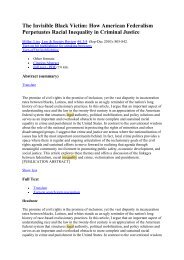Ski – resort and regional development: profile of visitors ... - E-Journal
Ski – resort and regional development: profile of visitors ... - E-Journal
Ski – resort and regional development: profile of visitors ... - E-Journal
You also want an ePaper? Increase the reach of your titles
YUMPU automatically turns print PDFs into web optimized ePapers that Google loves.
62<br />
Jaume Garau-Taberner<br />
competitiveness applied to the tourist sector, followed by a review <strong>of</strong> different attempts to<br />
measure competitiveness. An index will then be presented that is intended to improve on<br />
proposals made to date. Finally, a preview will be given <strong>of</strong> the results <strong>of</strong> a pilot study aimed<br />
at measuring dem<strong>and</strong> competitiveness. From a case study <strong>of</strong> five Mediterranean destinations<br />
(the Canaries, mainl<strong>and</strong> Spain, France, the Balearics <strong>and</strong> Italy), those factors that are most<br />
influential in determining competitiveness are identified.<br />
2. ATTEMPS AT MEASURING DESTINATION COMPETITIVINESS<br />
The new scenario, indicated above, has prompted academic literature to devote increasing<br />
attention to studies <strong>of</strong> destination competitiveness. A summary will now be made <strong>of</strong> some<br />
<strong>of</strong> the main contributions to date aimed at identifying <strong>and</strong> measuring factors that determine<br />
competitiveness in different destinations.<br />
2.1 Different attempts at measuring tourism competitiveness: a critical review<br />
2.1.1 The Calgary Model (Crouch <strong>and</strong> Ritchie, 1999)<br />
The Calgary model <strong>of</strong> competitiveness, developed by Pr<strong>of</strong>essors Crouch <strong>and</strong> Ritchie (1999),<br />
is one <strong>of</strong> the first conceptual <strong>and</strong> applied contributions to the field <strong>of</strong> destination competitiveness.<br />
The authors state that for a destination to be competitive in the long term, two types <strong>of</strong><br />
competitiveness are fundamental: i) a comparative advantage, represented by the resources<br />
available at the destination (human resources, physical resources, know how, the availability<br />
<strong>of</strong> capital, tourism infrastructure, <strong>and</strong> historical <strong>and</strong> cultural assets) <strong>and</strong> ii) a competitive edge,<br />
represented by the use the destination makes <strong>of</strong> these resources (audits <strong>and</strong> inventories,<br />
maintenance, growth <strong>and</strong> <strong>development</strong>, efficiency, effectiveness).<br />
To summarize, the main contribution <strong>of</strong> the Calgary Model is the fact that it outlines a series<br />
<strong>of</strong> factors that play a determining role in the competitiveness <strong>of</strong> a tourist destination <strong>and</strong>,<br />
additionally, it establishes certain categories, based on these factors’ importance as primary<br />
or secondary ones, etc.<br />
However, the same authors also point out some <strong>of</strong> the model’s shortcomings: i) many<br />
destinations do not have databases or indicators to assess many <strong>of</strong> the said factors; ii) in this<br />
purely conceptual model, what is missing is for each <strong>of</strong> the elements to be ranked in order<br />
<strong>of</strong> importance <strong>and</strong> given a relative weight, <strong>and</strong> iii) variables <strong>and</strong> indicators must be added to<br />
assess <strong>and</strong> measure aspects relating to the environment <strong>and</strong> the destination’s natural attributes.<br />
2.1.2 The World Travel <strong>and</strong> Tourism Council’s Tourism Competitiveness Monitor<br />
(Gooroochurn <strong>and</strong> Sugiyarto, 2005)<br />
The Tourism Competitiveness Monitor (henceforth the TCM), created by Gooroochurn <strong>and</strong><br />
Sugiyarto (2005), is one <strong>of</strong> the most courageous attempts to measure the competitiveness <strong>of</strong><br />
Tourism Today - Fall 2007 - Full Paper














